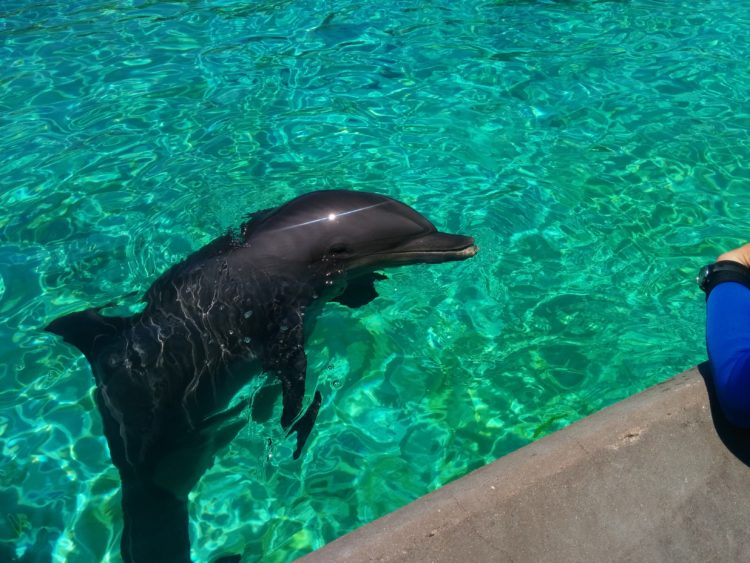On a recent trip to Sea World, I had an unexpected meeting with a retired sailor…a former member of the U.S. Navy Marine Mammal Program. Her name is Cascade, and she’s living out her retirement at Sea World.
Her trainer mentioned that Cascade used to protect nuclear submarines and did all kinds of interesting things for the U.S. Navy (USN). I suppose it isn’t a bad life for a dolphin. These mammals can live up to 30 years in the wild, but the trainers at Sea World said a few of dolphins live well into their 40s—largely because they don’t have to contend with sharks, and because the park has veterinarians on call for them whenever needed.
I also spoke to an acquaintance and USN veteran about this program, and he mentioned that Cascade may have been a bit of a troublemaker. Apparently not all dolphins turn out to be military material! According to him, some dolphins in the program require new homes because of their propensity for “doing their own thing.” He mentioned one dolphin disappeared during mating season. It was AWOL for two weeks before it returned to the program. He said some of these dolphins find a home at Sea World.
Here’s an excerpt from a previous article we published on the USN’s dolphin and sea lion program:
In the Fleet’s Operational Marine Mammal Systems (MMS), the Navy uses dolphins and sea lions to find and mark the location of underwater objects.
Dolphins are essential because their exceptional biological sonar is unmatched by hardware sonars in detecting objects in the water column and on the seafloor. Sea lions are used because they have very sensitive underwater directional hearing and exceptional vision in low light conditions.
Both of these marine mammal species are trainable for tasks and are capable of repetitive deep diving.
Some of the objects the animals find are expensive to replace. Others could present a danger to Navy personnel and vessels. The dolphins and sea lions work under the care and close supervision of their handlers and are generally trained for a particular operational capability called a “system.”
(The term “system” is engineering jargon for a collection of personnel, equipment, operations processes, logistics procedures, and documentation that come together to perform a specific job.)
However, animals may be crossed-trained for more than one system to better serve the needs of the Fleet. The term “mark” (MK for short) is military jargon for a type of thing within a category. There are 5 marine mammal systems called MK 4, MK 5, MK 6, MK 7, and MK 8. MK 4, MK 7, and MK 8 use dolphins; MK 5 uses sea lions; and MK 6 uses both sea lions and dolphins.
These human/animal teams can be deployed within 72 hours of notice and can be rapidly transported by ship, aircraft, helicopter, and land vehicles to potential regional conflicts or staging areas all over the world. They regularly participate in major Fleet exercises.
Already have an account? Sign In
Two ways to continue to read this article.
Subscribe
$1.99
every 4 weeks
- Unlimited access to all articles
- Support independent journalism
- Ad-free reading experience
Subscribe Now
Recurring Monthly. Cancel Anytime.
These animals are released almost daily untethered into the open ocean, and since the program began, only a few animals have not returned.”
The Mark 6 System
MK 6 MMS was first operationally deployed with dolphins during the Vietnam War from 1971 to 1972, and Bahrain from 1986 to 1987.
MK 6 has now expanded to include specially-trained sea lions to locate water-borne intruders and suspicious objects near piers and ships that pose a possible threat to military forces in the area. They have been shown to be effective under and around ships, piers, and in open water.
The sea lions were deployed to Bahrain as part of the effort to support missions under Operation Enduring Freedom.











COMMENTS
You must become a subscriber or login to view or post comments on this article.